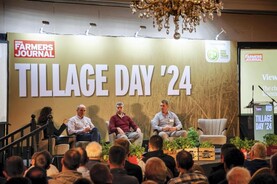The Department of Agriculture will increase efforts to encourage farmers to plant forestry on their land and offset greenhouse gas emissions, officials told the Oireachtas climate committee this week.
"On most drystock farms in Ireland, including in the west of Ireland and the northwest, forestry and beef farming can co-exist," secretary general Brendan Gleeson said.
He said that the average stocking rate on drystock farms was around 0.8 LU/ha.
They can raise the same number of beef cattle on their farms and plant trees and make a decent living from the acreage
"Most beef farmers have a very low stocking rate, they have some piece of marginal land that they don’t need or underuse, and they can raise the same number of beef cattle on their farms and plant trees and make a decent living from the acreage," Gleeson added, arguing that this was in their economic interest.
"There are different models; we have agroforestry schemes, we have ideas around lower density of forestry of deciduous trees, but also the potential for farmers to have commercial stands of forestry where they’ll get 100% establishment grant, they’ll get a significant income per hectare over the first 15 years, and then they’ll have the potential to make a commercial income from thinnings," he said.
A number of committee members shared their constituents' concerns in the face of sprawling forestry plantations, with Sinn Féin agriculture spokesperson Martin Kenny denouncing conifer "monoculture" in his Sligo-Leitrim constituency.
Sincerely-held views
Gleeson acknowledged that these were "sincerely held views," but added that they should not dominate the debate on forestry.
Fergus Moore, senior forestry inspector, said the Department would now work with farmers with successful forestry experience to share good news stories, while continuing to help farmers enter the industry through initiatives such as KT forestry groups.
"The message for the next eight to 10 years is to plant the wetter fields of their particular farm rather than planting the whole farm," Moore said.
He and Gleeson said that farmers remained the main participants in afforestation and the average plantation size was small at 8ha. Department figures show that 536 farmers planted 3,242ha of forestry last year, compared with 2,249ha planted by 353 non-farmers.
Read more
Afforestation payments to non-farmers doubled in past two years
Taking the 'but' out of forestry as a viable land use
Forests – complementing the farm enterprise
State-backed forestry drive shrouded in secrecy
The Department of Agriculture will increase efforts to encourage farmers to plant forestry on their land and offset greenhouse gas emissions, officials told the Oireachtas climate committee this week.
"On most drystock farms in Ireland, including in the west of Ireland and the northwest, forestry and beef farming can co-exist," secretary general Brendan Gleeson said.
He said that the average stocking rate on drystock farms was around 0.8 LU/ha.
They can raise the same number of beef cattle on their farms and plant trees and make a decent living from the acreage
"Most beef farmers have a very low stocking rate, they have some piece of marginal land that they don’t need or underuse, and they can raise the same number of beef cattle on their farms and plant trees and make a decent living from the acreage," Gleeson added, arguing that this was in their economic interest.
"There are different models; we have agroforestry schemes, we have ideas around lower density of forestry of deciduous trees, but also the potential for farmers to have commercial stands of forestry where they’ll get 100% establishment grant, they’ll get a significant income per hectare over the first 15 years, and then they’ll have the potential to make a commercial income from thinnings," he said.
A number of committee members shared their constituents' concerns in the face of sprawling forestry plantations, with Sinn Féin agriculture spokesperson Martin Kenny denouncing conifer "monoculture" in his Sligo-Leitrim constituency.
Sincerely-held views
Gleeson acknowledged that these were "sincerely held views," but added that they should not dominate the debate on forestry.
Fergus Moore, senior forestry inspector, said the Department would now work with farmers with successful forestry experience to share good news stories, while continuing to help farmers enter the industry through initiatives such as KT forestry groups.
"The message for the next eight to 10 years is to plant the wetter fields of their particular farm rather than planting the whole farm," Moore said.
He and Gleeson said that farmers remained the main participants in afforestation and the average plantation size was small at 8ha. Department figures show that 536 farmers planted 3,242ha of forestry last year, compared with 2,249ha planted by 353 non-farmers.
Read more
Afforestation payments to non-farmers doubled in past two years
Taking the 'but' out of forestry as a viable land use
Forests – complementing the farm enterprise
State-backed forestry drive shrouded in secrecy






 This is a subscriber-only article
This is a subscriber-only article










SHARING OPTIONS: